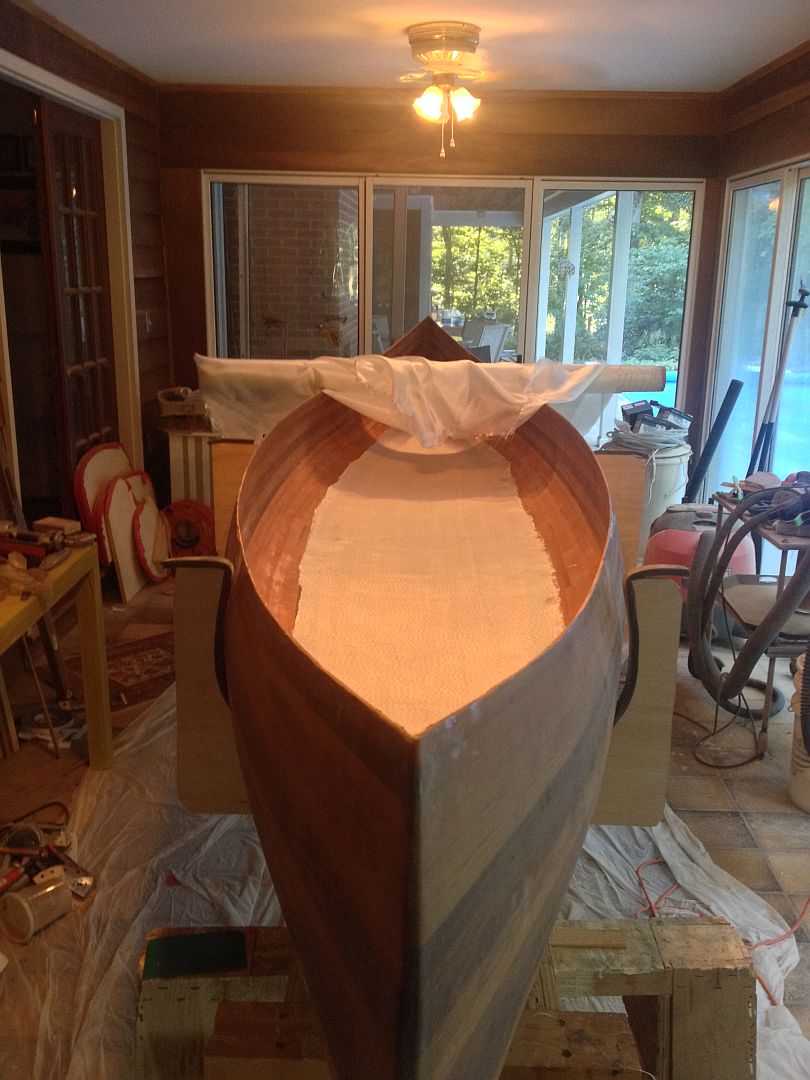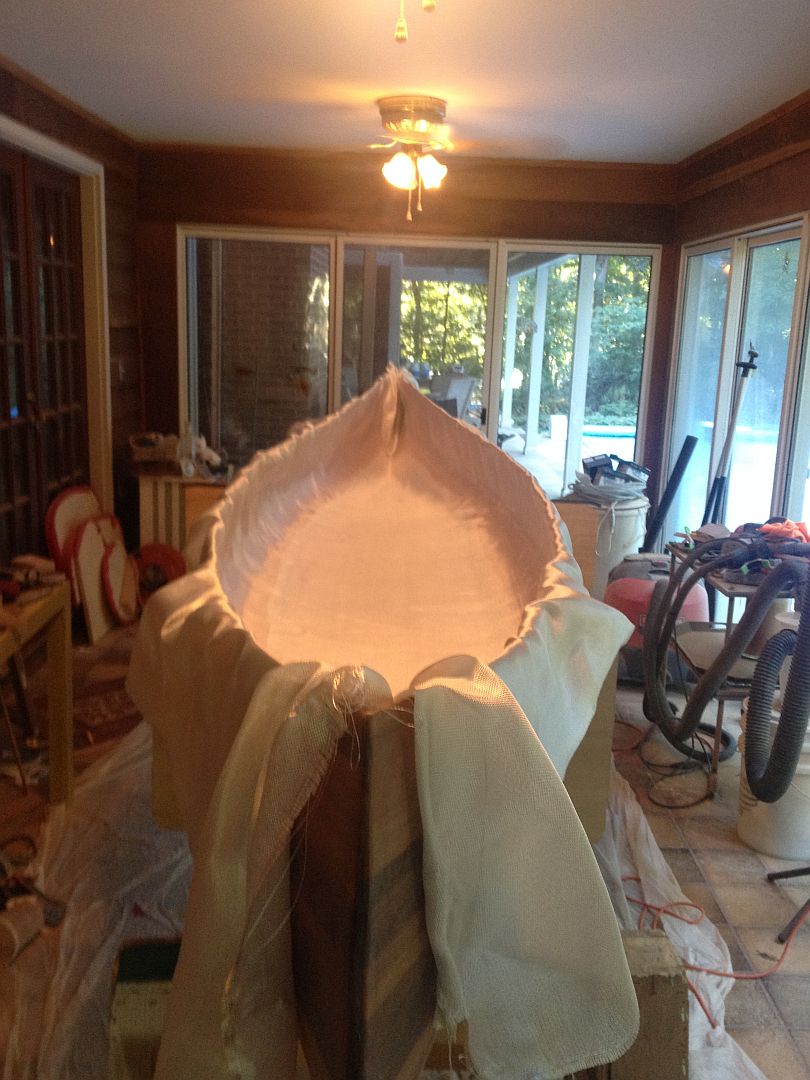Page 21 of 45
Re: A Slow Boat To Nowhere
Posted: Sun Sep 06, 2015 5:16 pm
by algale
jsburger wrote:
Al,
Just out of curiosity, how heavy is the canoe? The yoke is designed to be able to pick up the canoe and carry it on your shoulders as you know. Is that actually possible or is your canoe too heavy to carry any distance?
I was stationed in Quebec Canada at CFB Bagotville with the Air Force from 1980-1984. I hunted moose with a Canadian friend every year and even went back every year when I returned to the States until the first Gulf war in 1990. We had a 14" Cedar and canvas canoe that was hand built by the Tremble brothers in Jonquiere Quebec. It was truly made to portage, very light. The portage yoke was thinner and wider than yours and made from maple as were the seats. It was also scooped out front to back to match the curvature of the shoulders and had a notch in the curve to accommodate the spine. The seats were caned just like yours and the top side rails were Mahogany. We spent 30 days in the bush every year and I portaged that canoe more times than I care to think in 9 years.
You should be very proud of your work. That canoe is absolutely gorgeous.
The hull (still not fiberglassed inside) seems to weigh nothing, but I won't know the weight until it is finished and I can find an appropriate scale.
The design says the canoe should be 65 pounds when finished. I made some design changes that will alter that. First, I have chosen to reinforce the bottom, both inside and out, with an extra football-shaped layer of glass, which will add weight. Second, my seats and yoke are about 1/4 thicker than the plans called for.
Nevertheless, I believe the finished canoe will be something that can be portaged -- at least over short distances.
Thanks for checking in.
Al
Re: A Slow Boat To Nowhere
Posted: Sun Sep 06, 2015 5:26 pm
by jsburger
algale wrote:jsburger wrote:
Al,
Just out of curiosity, how heavy is the canoe? The yoke is designed to be able to pick up the canoe and carry it on your shoulders as you know. Is that actually possible or is your canoe too heavy to carry any distance?
I was stationed in Quebec Canada at CFB Bagotville with the Air Force from 1980-1984. I hunted moose with a Canadian friend every year and even went back every year when I returned to the States until the first Gulf war in 1990. We had a 14" Cedar and canvas canoe that was hand built by the Tremble brothers in Jonquiere Quebec. It was truly made to portage, very light. The portage yoke was thinner and wider than yours and made from maple as were the seats. It was also scooped out front to back to match the curvature of the shoulders and had a notch in the curve to accommodate the spine. The seats were caned just like yours and the top side rails were Mahogany. We spent 30 days in the bush every year and I portaged that canoe more times than I care to think in 9 years.
You should be very proud of your work. That canoe is absolutely gorgeous.
The hull (still not fiberglassed inside) seems to weigh nothing, but I won't know the weight until it is finished and I can find an appropriate scale.
The design says the canoe should be 65 pounds when finished. I made some design changes that will alter that. First, I have chosen to reinforce the bottom, both inside and out, with an extra football-shaped layer of glass, which will add weight. Second, my seats and yoke are about 1/4 thicker than the plans called for.
Nevertheless, I believe the finished canoe will be something that can be portaged -- at least over short distances.
Thanks for checking in.
Al
Well 65lbs certainly is not bad.
Re: A Slow Boat To Nowhere
Posted: Sun Sep 06, 2015 6:43 pm
by dusty
Yeah, now maybe. Wait a few years and then portage to the lake.
Re: A Slow Boat To Nowhere
Posted: Sun Sep 06, 2015 7:01 pm
by jsburger
dusty wrote:Yeah, now maybe. Wait a few years and then portage to the lake.
No, I don't want to do it now but in the 80's it was a piece of cake.

Re: A Slow Boat To Nowhere
Posted: Mon Sep 07, 2015 1:39 pm
by algale
Well, can't put off my least favorite part of the job any longer.
Laying out the glass "football."

- IMG_2522.JPG (140.37 KiB) Viewed 4622 times
More glass.

- IMG_2523.JPG (136.76 KiB) Viewed 4622 times
First coat of epoxy. Don't enjoy working with glass and epoxy at all.

- IMG_2525.JPG (159.19 KiB) Viewed 4622 times
Trying to decide whether I want to add additional coats of epoxy. The weave looks like it might make a decent non-slip surface. Question for Shipwright (or anyone else who knows fiberglass/epoxy): is there any reason why I need to add a second and third coat to the interior?
Re: A Slow Boat To Nowhere
Posted: Mon Sep 07, 2015 4:57 pm
by rjent
algale wrote:Well, can't put off my least favorite part of the job any longer.
Laying out the glass "football."
IMG_2522.JPG
More glass.
IMG_2523.JPG
First coat of epoxy. Don't enjoy working with glass and epoxy at all.
IMG_2525.JPG
Trying to decide whether I want to add additional coats of epoxy. The weave looks like it might make a decent non-slip surface. Question for Shipwright (or anyone else who knows fiberglass/epoxy): is there any reason why I need to add a second and third coat to the interior?
I built a twin outboard ski boat in the 60's. I think that your strength is there. The rest is just cosmetic. Since this could be a "portage" boat, the less glass you lay, the lighter it will be. Glass is very strong stuff ....

JMHO
Re: A Slow Boat To Nowhere
Posted: Wed Sep 09, 2015 3:34 am
by shipwright
You're good Al. As long as the glass is fully wetted out (transparent) you don't need to use more epoxy. It's just weight and expense.
Looks great!
Re: A Slow Boat To Nowhere
Posted: Sat Sep 19, 2015 5:56 pm
by algale
Entire day spent milling the Sapele gunwales (3/4 x 3/4) and then trying to figure out how best to scarf them.
Ultimately, I built a version of a jig I found on the internet.
The runner is a scrap of Sapele milled to fit the miter slot and stand a little proud. It is then set in a groove cut in the 1/2 inch plywood base and glued and screwed in place. The fence is more Sapele, just screwed in place at the appropriate angle. The jig is then run through the blade to cut off the extra fence and base, leaving you with this.

- IMG_2530.JPG (248.66 KiB) Viewed 4058 times
Pretty sure you hot shots would have churned this out in less than an hour. It took me a lot longer.
I used the jig to cut the first two scarfs, which I dry fit to check the fit. Looks pretty good. There's about 6.125 inches of joint over the .75 inch width of the joint, so 8:1, which I read was sufficient (someone speak up if they think that's too short?).
Tomorrow I'll mix up some epoxy and glue 'em up.
Re: A Slow Boat To Nowhere
Posted: Sat Sep 19, 2015 6:04 pm
by shipwright
Sounds good Al. That's a great jig to cut these.
8:1 is great too. That's the ratio I use all the time. Never had one break on the glue.I believe I read a piece from the American Plywood Institute or some such body that said 8:1 was equivalent to a continuous piece (plywood). It should be as good or even better in solid wood.
Re: A Slow Boat To Nowhere
Posted: Sat Sep 19, 2015 6:41 pm
by algale
shipwright wrote:Sounds good Al. That's a great jig to cut these.
8:1 is great too. That's the ratio I use all the time. Never had one break on the glue.I believe I read a piece from the American Plywood Institute or some such body that said 8:1 was equivalent to a continuous piece (plywood). It should be as good or even better in solid wood.
Thanks for the sanity check, Paul! I am hopeful I will launch before our lakes and ponds freeze over here in Maryland!